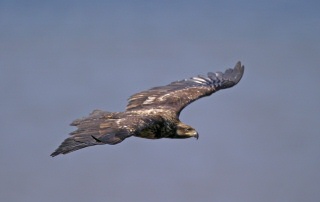Stow Creek Road, Stow Creek Landing, NJ
Phone: (856) 984-0370
www.njparksandforests.org
NJ Department of Environmental Protection
From the Zoo or the main parking lot at Sunset Lake, at the intersection of CR 621/
West Park Dr. and CR 607/West Ave. (named Beebe Run Rd. to the north), turn left onto CR 607 South. Follow CR 607 for 1.1 miles to the inter-
section with Route 49. Cross Route 49 and immediately bear right onto CR 626/Roadstown Rd. Follow CR 626 for 5.2 miles to CR 604. Bear left onto CR 604 and travel approximately 0.6 miles to Stow Creek Elementary School. Continue straight past the school onto CR 660/ Stow Creek Landing Rd. (CR 604 turns left to the side of school here),
for 0.2 miles to the intersection with CR 602.
Cross CR 602 and bear Left to continue on CR 660. Follow CR 660 to its dead end at Stow Creek Landing in Stow Creek State Park (about 3.4 miles). Note: Once outside Bridgeton, there are very few facilities, so please plan ahead. Map
Both resident and wintering Bald Eagle may be seen perched in tall trees at water’s edge, soaring high overhead or flying low over the fields and water in search of prey. Northern Harrier, Red-tailed Hawk, Rough-legged Hawk and Great Blue Heron are also here through the winter despite the sometimes bitter cold winds off the Bay. In January, Great Horned Owl are on nests, followed by Bald Eagle in February.
The marsh comes alive with the arrival of warmer temperatures. Marsh Wren and Red-winged Blackbird sing throughout the day blending their songs with those of a host of other passerines, and various species of frogs and toads in what might be described as a marshland chorus. Turtles and salamanders emerge from their sub-surface winter hideouts. Muskrat, deer, fox, skunk, raccoon, rabbit and other small
animals search for food in the marsh and in the undergrowth at the edge of the marsh. Great Horned Owl and Bald Eagle are busy tending their newly hatched offspring.
“Sultry” may best describe the summer days in the marshlands along the bay. The air can be swarming with insects — mosquitoes, various flies, gnats and dragonflies. Swallows love it; humans don’t. If you visit this time of year, be prepared — bug spray and long-sleeved shirts are highly recommended. Early morning is the best time to view wildlife as most species retreat from the summer heat and are difficult to locate later in the day. If you venture out, you may be rewarded with sightings of Yellow-breasted Chat, Eastern Meadowlark, or Blue Grosbeak.
Migration time is here; thousands and thousands of Canada and Snow Geese arrive to spend the winter along the bayshore. Occasionally, Tundra Swans will join them. Raptors ride
thermals and can sometimes be seen kettling over the marsh. These kettles may contain several species of hawks as they migrate southward. In fact, this part of the state is one of the best places to see American Kestrel. The cool fall air presents visitors with ideal conditions for hiking and birding.
| |
 |
| Immature Bald Eagle | Kevin Karlson |
| |
Stow Creek flows before you as it winds its way to the Delaware Bay. The Bay is only about five miles away “as the crow flies,” but it is more than twice that distance navigating its twists and turns. Scan the groves of large trees on the far side of the Creek — these are favorite perching sites for Bald Eagle. The tall trees to your left are frequently visited by Red-tailed Hawk and the brushy fields and small
trees on both sides of the road are habitat for American Goldfinch, a variety of sparrows and an occasional oriole. The cooling tower at the Salem Nuclear Plant may be seen to the northwest, about seven miles away.
HABITAT ALONG STOW CREEK AND THE BAYSHORE
The habitat at Stow Creek Landing is representative of several other sites on this route as you take several “out-and-back trips” from the main road to the water’s edge.
All along the Bayshore, vast tidal marshes, with dense growths of tall grasses, such as native spartina alterniflora, also known as smooth cord grass, and non-native phragmites, provide ideal habitat for a variety of wildlife. Muskrat, Marsh Wren, rails, Red-winged Blackbird and a host of other birds, mammals, reptiles and insects, thrive in these fecund surroundings. The abundance of insects makes these marshlands favorite hunting grounds for swallows and Purple Martin, which can often be seen perched by the dozens on telephone lines throughout the area. The marshlands are also ideal habitat for foraging Northern Harrier. Egrets and herons search for food in the shallow waters along the banks while the open waters are feeding grounds for waterfowl and fishing grounds for Osprey and eagles. At the edge of the marshlands, the forest, with thick undergrowth, is home to an array of other wildlife. Deer, red fox, other small mammals,
and a great variety of birds, reside in the
forest thickets and along the forest edge.
While the marshy habitats at the sites you visit along this route are similar in structure and form, each site provides a new opportunity to see something not seen before. Use the following seasonal descriptions for the next three stops on the trail.
|